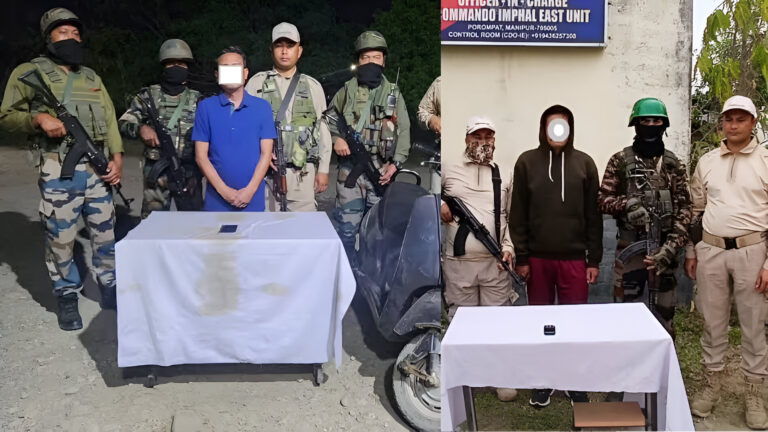Manipur Security Forces Recover Huge Cache of Arms & Ammo – A Comprehensive Analysis
Introduction
Have you ever wondered what it takes to keep a community safe in an area where the shadows of illegal arms and ammunition loom large? In Manipur, a recent operation by security forces has turned the spotlight on this very issue. They successfully recovered a huge cache of arms and ammunition, an act that not only demonstrates their tactical prowess but also underscores the ongoing challenges posed by illegal arms trafficking and insurgency in the region.
In this detailed analysis, we’ll break down the incident, explore the broader security implications, and look at what this means for the future of law enforcement in Manipur. Whether you’re a local resident, a security enthusiast, or simply curious about the complexities of modern policing, this article is designed to keep you informed and engaged. So, let’s dive in and unravel the layers behind this significant recovery operation.
The Incident: What Really Happened?
On that eventful day in Manipur, security forces executed a well-planned operation that led to the recovery of a massive cache of arms and ammunition. Picture this: while routine intelligence operations were underway, a tip-off pointed to a hidden stash of weapons that could potentially fuel illegal activities. Acting swiftly, the security forces mobilized, and what followed was a carefully orchestrated raid.
This isn’t your everyday police action—it was a high-stakes operation where every second counted. The forces involved demonstrated precision and coordination, ensuring that the arms did not fall into the wrong hands. The recovered cache included a variety of arms and a significant amount of ammunition, hinting at a well-organized network behind the illegal arms trade.
Imagine a scenario where a hidden arsenal is discovered, much like uncovering a secret room filled with forbidden treasures. However, instead of riches, these “treasures” could incite violence and instability. That’s why this operation is such a big deal: it sends a clear message that law enforcement in Manipur is on high alert and ready to neutralize threats before they escalate.
The Background: Why Are Arms and Ammunition Such a Concern?
To understand the magnitude of this discovery, it’s essential to delve into the context. Manipur, located in the northeastern part of India, has a history that is as rich as it is complex. The region has seen its fair share of political unrest, insurgency, and even cross-border issues that have sometimes blurred the lines between legal and illegal arms trading.
Illegal arms trafficking in Manipur isn’t just a minor issue—it’s a significant challenge that has far-reaching consequences. When weapons are smuggled or stored illegally, they have the potential to empower insurgent groups, fuel criminal activities, and destabilize the delicate balance of security in the region. Over the years, the authorities have been on constant alert, trying to stem the flow of these dangerous materials.
Think of it like a leaking faucet: if you don’t fix it, the constant drip can eventually lead to a flood. In this case, the “flood” is the proliferation of illegal arms that could transform local conflicts into widespread violence. The recovery of this cache is not just a victory for law enforcement—it’s a critical step in preventing future chaos.
Inside the Operation: Tactics and Execution
So, how did the security forces pull off this impressive feat? Let’s break it down into the key steps:
Intelligence Gathering
Before any physical action took place, there was a robust intelligence-gathering phase. Sources within local communities, undercover agents, and technological tools such as surveillance cameras all played a role in piecing together the puzzle. The intelligence indicated that the cache was strategically hidden in a remote area, making it a challenging target.
Imagine being a detective in a mystery novel—every clue counts, and the slightest piece of evidence can lead you to the truth. That’s exactly what the security forces did. They pieced together various bits of information, like fragments of a jigsaw puzzle, to form a clear picture of the cache’s location.
Strategic Planning and Coordination
Once the intelligence was solid, a detailed plan was drawn up. The operation involved multiple teams working in perfect sync. Communication was key; every unit had a specific role to play. The coordination among these teams was reminiscent of a well-rehearsed dance, where every move was precise, and timing was everything.
The planning phase also involved contingency measures—what to do if the operation didn’t go as planned, how to handle potential resistance, and ensuring the safety of the officers involved. In such high-risk scenarios, the smallest mistake can have severe consequences. Thankfully, the meticulous planning ensured that the operation was executed smoothly.
Execution: The Raid
The moment of execution was like the climax of a thriller movie. At the designated time, security forces moved in swiftly. The raid was conducted with surgical precision, leaving no room for error. The element of surprise played a crucial role here; the suspects were caught off guard, unable to mount an effective defense.
During the operation, the teams swiftly secured the area, neutralized any potential threats, and began the process of inventorying the recovered items. The cache was not only extensive but also comprised a variety of weapons—ranging from small arms to larger calibers—and a substantial amount of ammunition. It was a stark reminder of how organized and potentially dangerous these criminal networks can be.
Aftermath and Analysis
After the operation, experts and law enforcement agencies began analyzing the recovered cache. Each weapon and piece of ammunition was meticulously documented, providing valuable insights into the scale and sophistication of the network behind the illegal arms trade. This analysis is crucial for future operations, as it helps authorities understand the methods used by traffickers and develop more effective countermeasures.
Security Implications: What Does This Mean for Manipur?
The recovery of such a huge cache has far-reaching implications for the region’s security landscape. Let’s explore a few of the key aspects:
Disrupting Criminal Networks
First and foremost, this operation strikes a significant blow to the criminal networks involved in arms trafficking. By seizing a large cache of weapons, the authorities have not only curtailed the immediate threat but also sent a powerful message to other potential traffickers. It’s akin to cutting off a major artery in a criminal organization’s body—the repercussions will be felt throughout the network.
Preventing Future Violence
Illegal arms can easily escalate conflicts, turning local disputes into violent confrontations. By recovering these weapons, law enforcement has potentially averted future incidents that could have resulted in injuries, loss of life, and widespread panic. Every piece of recovered ammunition is a step away from a possible tragedy.
Strengthening Community Trust
For the local communities, the success of this operation is a reassuring sign. It builds trust in the security forces and reassures citizens that their safety is a priority. When people see that law enforcement is actively working to keep them safe, it fosters a sense of confidence and unity within the community.
Enhancing Regional Stability
Manipur has long been a region of strategic importance and sometimes, political volatility. The recovery of this arms cache plays a pivotal role in stabilizing the area, reducing the risk of insurgency, and ensuring that illegal activities do not compromise the region’s overall stability. It’s a win not just for the local authorities but for the entire nation.
Political Repercussions and Public Debate
No major law enforcement operation occurs in a vacuum—there are always political and public ripples to consider. The recovery of this massive cache has stirred debates among political leaders, policymakers, and the general public.
Government Accountability and Policy Reforms
Politicians are now under the spotlight, with many questioning whether existing policies are robust enough to prevent such threats. This incident might spur the government to introduce stricter regulations and more comprehensive policies to combat illegal arms trafficking. The focus is on balancing national security with civil liberties, ensuring that while the state protects its citizens, it also respects the rights and freedoms of its people.
Public Opinion: A Mix of Relief and Concern
On one hand, citizens are relieved that the authorities are actively dismantling criminal networks. On the other, there is an underlying concern about how these weapons ended up in the first place. Public debates have erupted on forums and social media, with many urging for deeper investigations into the sources of these illegal arms. This dialogue is crucial as it pushes for transparency and accountability, ensuring that the state remains vigilant against such threats.
Impact on Regional Politics
The political landscape in Manipur is intricate, with various parties and interest groups vying for influence. The successful operation has undoubtedly bolstered the standing of the current administration, showcasing its commitment to law and order. However, opposition leaders are quick to use the incident to question the effectiveness of past policies and demand a long-term strategy to prevent recurrence.
Community Impact: Living with the Shadow of Illicit Arms
For the people of Manipur, the recovery of this cache is a double-edged sword. Let’s look at how it affects everyday life in the region:
A Sense of Security Restored
For many residents, knowing that security forces are on top of the situation brings a sense of relief. It reassures them that their safety is paramount and that the state is actively working to protect them. This is especially important in areas where the fear of insurgency or criminal violence can cast a long shadow over daily life.
The Lingering Questions of Trust
However, the operation also raises questions about how such a massive cache was amassed in the first place. Many community members are left wondering about the effectiveness of existing surveillance and law enforcement measures. This sense of lingering mistrust can sometimes result in heightened community vigilance, with locals taking matters into their own hands by forming neighborhood watch groups or participating more actively in local governance.
Economic and Social Consequences
The presence of illegal arms in any region can have far-reaching economic implications. Businesses may face disruptions, and the overall investment climate can be affected when areas are perceived as high-risk. While the recovery operation is a positive step, it also highlights the need for long-term strategies to ensure that the illegal arms trade does not resurface and destabilize the local economy.
Historical Context: Arms Trafficking in the Northeast
To fully grasp the significance of this operation, it helps to consider the historical context of arms trafficking in the Northeast of India. This region has, for decades, been a crossroads for various interests, with porous borders and long-standing insurgent movements contributing to a thriving—but dangerous—black market for arms.
Cross-Border Challenges
Manipur shares borders with countries where arms trafficking has been a persistent issue. The porous nature of these borders, combined with historical insurgencies, has made it relatively easy for arms to find their way into local markets. The recent recovery is part of a larger, ongoing effort to secure these borders and clamp down on illegal activities that cross them.
The Evolution of Criminal Networks
Over time, the networks involved in arms trafficking have grown more sophisticated. What might have once been small, localized groups have evolved into well-organized criminal syndicates capable of moving large quantities of weapons and ammunition. The recovered cache is a testament to this evolution—it shows that these networks are not only extensive but also highly organized, necessitating equally advanced countermeasures.
Leveraging Technology in Modern Law Enforcement
One of the most exciting aspects of recent operations like this one is the role of technology in modern law enforcement. Today, authorities have access to a suite of advanced tools that help them track, analyze, and intercept illegal activities.
Surveillance and Data Analytics
From high-definition surveillance cameras to sophisticated data analytics platforms, technology has transformed how law enforcement agencies operate. These tools allow for real-time monitoring and rapid response, which are crucial in operations involving large caches of arms and ammunition.
Communication and Coordination
Modern communication tools ensure that different units can coordinate seamlessly during operations. Whether it’s sharing live footage or rapidly disseminating intelligence, technology bridges the gap between on-ground teams, making operations more efficient and effective.
Future Technological Advancements
Looking ahead, further technological advancements will only enhance the capabilities of law enforcement. Artificial Intelligence, machine learning, and predictive analytics could soon become standard tools in the fight against illegal arms trafficking, helping authorities to anticipate and prevent future incidents before they occur.
Collaborative Efforts: A United Front Against Crime
The recent operation is also a powerful reminder of the importance of collaboration in law enforcement. No single agency can tackle the issue of illegal arms trafficking alone—it requires a coordinated effort that brings together multiple stakeholders.
Inter-Agency Cooperation
In Manipur, the success of this operation is largely due to the seamless cooperation between various law enforcement bodies. Local police, intelligence units, and even border security forces all played pivotal roles. This collaborative approach not only enhances operational efficiency but also builds a robust network that is better equipped to handle future challenges.
Community Involvement
Community participation is another critical component. When local residents actively engage with law enforcement, sharing tips and insights, it creates a formidable barrier against criminal activities. The trust and cooperation between the authorities and the community can be the difference between a sporadic crackdown and sustained long-term peace.
The Road Ahead: Policy Reforms and Long-Term Strategies
While the recovery operation is a significant achievement, it’s only one piece of a much larger puzzle. The fight against illegal arms trafficking requires ongoing vigilance and comprehensive policy reforms.
Enhancing Border Security
Given Manipur’s strategic location, strengthening border security is paramount. Investments in advanced surveillance technologies and border patrols can help ensure that illegal arms do not easily cross into the region.
Legislative Reforms
Lawmakers must also re-examine existing legislation related to arms trafficking and extortion. Stronger penalties, tighter controls, and improved legal frameworks will deter criminal networks from attempting similar operations in the future. The government’s response to this incident could pave the way for sweeping reforms that enhance national security.
Economic and Social Initiatives
At the heart of many security challenges lie deeper socio-economic issues. By addressing these underlying causes—through job creation, education, and community development—the state can reduce the appeal of criminal networks and create a more stable, prosperous society.
Conclusion
The recovery of a huge cache of arms and ammunition by Manipur security forces is a milestone in the ongoing battle against illegal arms trafficking and organized crime. This operation not only showcases the tactical brilliance and dedication of law enforcement but also highlights the urgent need for a comprehensive, multi-faceted approach to regional security.
From the intelligence gathering that set the stage for the operation to the meticulous execution and the subsequent analysis, every step has been a testament to the evolving landscape of modern policing. Yet, this incident also serves as a sobering reminder of the challenges that lie ahead—from the persistent threat of illegal arms to the socio-economic factors that fuel such criminal activities.
As we look forward, it’s clear that the path to long-term stability in Manipur and similar regions requires a united front. This means leveraging advanced technology, fostering community engagement, enhancing inter-agency cooperation, and implementing robust policy reforms. Only by addressing both the symptoms and the root causes can we hope to build a future where security and prosperity go hand in hand.
Ultimately, the operation in Manipur is more than just a law enforcement success story—it’s a call to action for all stakeholders involved. It urges us to remain vigilant, proactive, and committed to creating a safer environment for every citizen. Together, by working collaboratively and thoughtfully, we can ensure that incidents like these remain isolated events, paving the way for a brighter, more secure future for all.
Frequently Asked Questions (FAQs)
- What exactly was recovered in the Manipur arms cache operation?
Security forces recovered a large cache of arms and ammunition, including various types of small arms and significant quantities of ammunition, indicating a well-organized network behind illegal arms trafficking. - How did law enforcement locate and recover the hidden arms?
The operation was preceded by extensive intelligence gathering, surveillance, and meticulous planning. Multiple agencies worked together, using both human intelligence and modern technology, to identify and raid the hidden cache. - What are the potential security implications of such a large cache being found?
The recovery disrupts criminal networks and prevents the possibility of these weapons fueling future violence or insurgency. It also enhances community trust and strengthens regional stability by curbing illegal arms trafficking. - How might this operation influence future law enforcement strategies in Manipur?
This success underscores the importance of intelligence-led, collaborative operations. Future strategies are likely to integrate advanced technologies, stronger inter-agency cooperation, and proactive community engagement to prevent similar incidents. - What policy reforms could help prevent the recurrence of such illegal arms trafficking?
Potential reforms include enhanced border security measures, stricter legislation on arms trafficking, economic and social initiatives to address root causes, and improved legal frameworks to deter and penalize criminal networks effectively.




